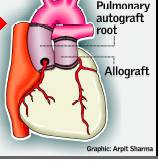Hearty news: Rare double surgery rescues teen...
Written on Sunday, November 05, 2006 by Gemini
Ref: Times News Network
Thirteen-year-old Pinky Mandal is one in a million. Her cherubic face, big, innocent eyes and slim body belie the precarious condition she was in. With triglycerides over 500 (normal is 150), she has clumps of fat all over her body — eyelids, palms, legs and even inside her heart. She suffered from coronary artery disease (CAD) and severe aortic stenosis, a disorder where excessive calcium gets deposited in heart valves. However, a rare surgery on October 22 here, involving coronary artery bypass grafting (CABG) and Ross procedure, has given her a new lease of life. This is probably the first time both surgeries have been done together and that too in someone so young.
In fact, nearly 1.8 lakh children are born with CAD each year. Nearly one-third to half of these are critical, requiring intervention in the first year itself. Also, the total number of cardiac surgeries done for CAD at all age groups in India is approx 6,500 per year. ‘‘But Pinky’s condition,’’ says Dr Anil Bhan, director, cardiothoracic vascular surgery, Max Heart Institute, ‘‘was also a genetic one called familial hyperlipidemia. It’s marked by high levels of blood fat, high serum, low density lipoprotein (LDL) cholesterol, low levels of high density lipoprotein (HDL) and a family history of heart disease. It usually shows up during the teen years.’’
Her high lipid levels led to the aortic valve getting clogged. Net result was constant angina pain, a rare thing among children, breathlessness and blood in sputum. Going to school for the Class VII student, daughter of a sweeper from Kolkata, was an uphill task. She would often need to take rest and was unable to walk for long. Incidentally, blood is pumped from the left ventricle, through the aortic valve and to the aorta, which in turn supplies blood to the rest of the body. In fact, these fatty deposits, called zanthomas, can be seen all over her body (see pix). The Ross procedure is named after English surgeon Dr Donald Ross. It’s an innovative means of valvular replacement for the aortic valve, particularly in children.
The double surgery which lasted four hours has changed the dim outlook of Pinky’s life. The diseased aortic valve was transplanted by Pinky’s pulmonary valve which acted like a prosthesis. A conduit, made of bovine pericardium (sac around the heart), was put in place of the pulmonary valve. ‘‘However, both valves should match in size and the difference should be less than 3 mm,’’ says Bhan.
Although the surgical procedure itself is technically more demanding, it has advantages over traditional procedures. As the grafted tissue is alive and not a mechanical valve, there’s no need for blood thinners for life. Also, there is the risk of infection of the mechanical valve. A mechanical valve will also not grow as the child grows. The mortality for this surgery is as low as other similar surgical procedures.
Pinky, meanwhile, seems a little bewildered, her tired eyes speaking volumes. ‘‘I don’t feel any breathlessness or pain in my chest,’’ whispers the frail child as she lies curled up on the hospital bed. She will need to take medication all her life and the fat deposits on her body will have to be removed. This may get done at AIIMS, says Bhan. The Ross procedure is done only at a few centres—AIIMS, Max, Narayana Hrudayalaya, Bangalore and a centre by Dr K M Cherian.
Pinky’s surgery, which would normally cost about Rs 2 lakh, was free and part of the Devi Nathurmal Project whereby underprivileged children with heart diseases are treated and funds generated through donations. Over 50 children have been treated so far from Uttaranchal, J&K, HP, Rajasthan and Punjab.
FAT OF THE MATTER
13-year-old Pinky Mandal in hospital after undergoing coronary artery bypass grafting along with Ross procedure. Notice the fat deposits on her palms and hands
STEP 1
Pulmonary valve and segment of pulmonary artery are excised. This will replace the diseased aortic valve 
STEP 2
Diseased aortic valve and proximal tissue are removed, leaving the right and left coronary arteries with only a button of tissue
STEP 3
Pulmonary autograft placed in aortic position and buttons of tissue on both right and left coronary arteries are sewn into pulmonary segment and closed

